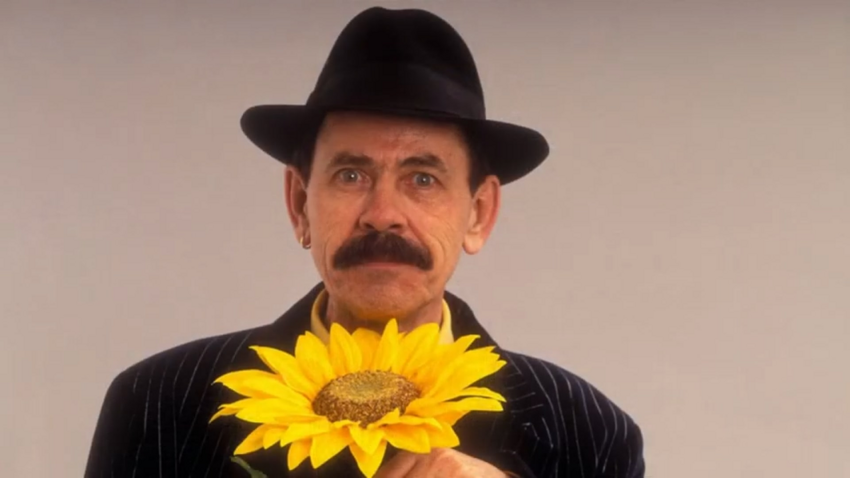“Where is Scatman?”: what happened to the superstar of the 90s (3 photos + 1 video)
In the 90s, from almost every “iron” came the cheerful: “I’m the Scatmaaaan!!!” Young people rocked out to this hit at the coolest discos, and older people tried to sing along, shamelessly distorting the difficult-to-pronounce “scoobie oobie doobie scoobie doobie.” 
And it was impossible to believe that the author of this speech therapy nightmare is a 52-year-old stutterer with a gorgeous mustache, John Larkin. How did a 100% disabled person with a very mediocre appearance manage to conquer the musical Olympus and what happened to him then? Let's delve into the biography of this specific character.
early years
The future Eurodance hip-hop star was born in El Monte, California on March 13, 1942. Since childhood, the boy stuttered terribly, for which he received full punishment from his peers. He had no friends, so little Johnny looked for solitary entertainment. One day, in the pantry at home, he found a box of jazz records. The music struck him to the very heart. From the age of 12, the boy devoted himself to playing the piano. In a later interview, Larkin admitted that through music he spoke to the outside world, with which, due to his stuttering, he was embarrassed to communicate directly.
At the age of 14, John heard the then popular scat performed by Ella Fitzgerald and Louis Armstrong and firmly decided to master this direction. Innate talent allowed Larkin to earn the status of a professional jazz pianist by the age of 30. He was actively invited to perform in Los Angeles clubs, and in 1986 he released his first album, Transition. However, the debut album was a complete failure. Listeners preferred famous jazz performers and ignored Larkin's album.
Against the background of failures, John first became addicted to alcohol, and then became closely acquainted with drugs. Soon the addiction brought his best friend, musician John Farrell, to the grave. Then Larkin decided to quit using psychotropic substances. His fiancée, Judy Custer, supported her lover's idea. She suggested radically changing the situation and moving to live in Europe.
Rise of Scatman
In 1990, the couple settled in Berlin. John made his living performing in jazz clubs and on cruise ships. Europeans warmly welcomed the talented American. The song “On the Sunny Side of the Street” performed by him more than once received thunderous applause and demands for an encore. Larkin's agent Manfred Zaringer quickly realized that he could make good money from this and suggested that the artist mix scat singing with Eurodance and hip-hop motifs. 
For fear of ruining the song and being ridiculed again for his stuttering, on the recording of Scatman (Ski Ba Bop Ba Dop Bop) John jabbered like crazy in order to have time to pronounce the entire lyrics in one breath before the next throat spasm. It turned out even better than Zahringer dreamed. The hit blew up the European music charts.
Career peak
In 1995, Larkin sold more than 6 million copies of his instantly immortal hit, recorded a dozen more songs, released the album Scatman’s World and conducted several tours in Europe and Asia. The start of concerts often had to be delayed. Fans squealed with delight for hours at the mere appearance of Scatman on stage. And only after the crowd had calmed down a little did the singer begin his performance.
In China, the colorful performer has literally become everyone's favorite. He was literally idolized. Asians swept toys with Scatman images off the shelves. His photo was printed on Japanese cosmetics, cola cans, dessert packaging, and phone accessories.
There were legends about the artist's hat and mustache. Journalists put forward amazing versions about the work of leading couturiers of European fashion houses on Larkin's image. The artist could not stand such attention to his person and stated that he simply covered his bald head with a hat, and a mustache, as he himself thought, added respectability. A black formal suit is considered the most appropriate clothing for a man over 50. No stylists ever gave him advice on improving his appearance.
What's left behind the scenes?
“In general, I’m used to the most ordinary things,” John once answered meticulous journalists. Even the fame and money that fell upon Larkin did not change this principle. Despite the millions in fees, he led a very modest lifestyle. Scatman donated almost all of his earnings to the National Association for Stuttering in the USA. The singer often took part in the organization’s forums and took care of its little pupils in every possible way. John and Judith were not lucky enough to experience the joy of parenthood, so they gave all their unspent love to children with speech disabilities. John constantly repeated to his students that even the biggest problem can be turned into a strength. 
In 1999, he was awarded the ASHA Award for Distinguished Service to the Stuttering Community, and Larkin was later inducted into the American Stuttering Association Hall of Fame.
The news of inoperable lung cancer dashed the singer’s grandiose plans. For about two years he fought the disease, while maintaining enviable optimism. The artist did his best to encourage his grief-stricken friends and never tired of saying that he had lived a wonderful life, experienced beauty and was generally grateful to God for everything.
In the time remaining to him, the artist managed to record the album Take Your Time. On November 26, 1999, during a concert, Scatman lost consciousness, and on December 3 he died. At the age of 58, Larkin died at his home in Los Angeles. Already aware of his approaching death, the singer insisted on cremation. John was categorically against having a memorial built from his grave.
The farewell ceremony took place on a yacht in the ocean off the coast of Malibu. Surrounded by numerous friends and to the accompaniment of a jazz trio, John's ashes were scattered over the ocean.
Few musicians managed to achieve immortality during their lifetime thanks to their creativity. Scatman, with the help of rare talent and hard work, managed to go beyond the boundaries of time. Fans still flood the singer’s personal blogs with letters of gratitude. And although the artist is no longer physically with us, his personality remains an example of simplicity, modesty, openness and philanthropy worthy of imitation.
And finally, in case anyone forgot, Scatman’s most famous song:






























